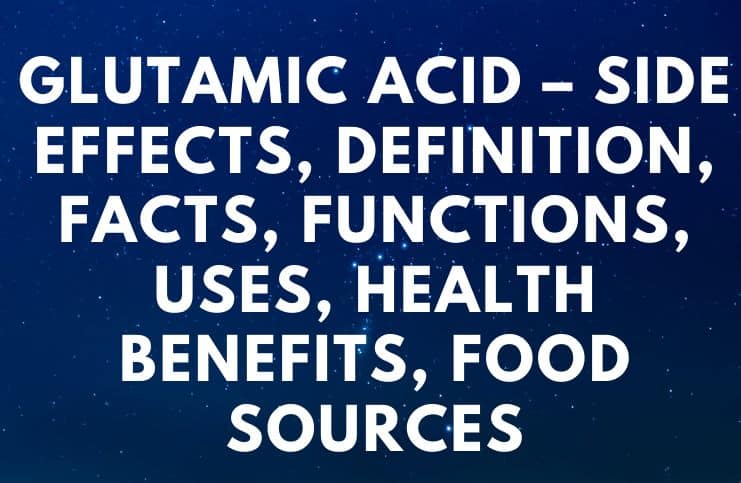Glutamic Acid – Side Effects, Definition, Facts, Functions, Uses, Health Benefits, Food Sources:
Facts
It is a non-essential amino acid, that is very frequent in plants and animals. Besides being a building block of protein, this amino acid is vital in the transmission of nerve impulses and is even produced in the brain. Chemical formula – HOOC-CH(NH2)-(CH2)2-COOH.
The carboxylate anions and salts associated with E620 are referred to as glutamates. A typical human contains 4.4 pounds of glutamate. It is an important component of proteins and peptides and is present in most tissues.
Uses and functions
One of the major roles of this non-essential amino acid is as an excitatory neurotransmitter inside the central nervous system. It’s the most common neurotransmitter found inside the brain and spinal cord.
As a neurotransmitter, glutamate influences several areas of the brain, including the thalamus, basal ganglia, spinal cord, brain stem, and pons. Before it can act as a neurotransmitter, it must be connected to specific receptors based in the central nervous system.
One of these receptors, known as the N-methyl-D-aspartate (NMDA) receptor, and here it regulates the number of sodium, calcium, and magnesium ions that can exit and enter the cells.
Health Benefits
It is in the same amino acid family group as glutamine, and they can transform their structure to transform into each other.
- Glutamine plays a very important role in the tumor cell. At first, it acts as a nitrogen donor in the nucleotide (organic molecules) and amino acid biosynthesis, secondly, it helps in the uptake of essential amino acids and it keeps the activation of TOR kinase.
- It increases brain function and mental activity. It is the most stimulating neurotransmitter in the central nervous system of the body, according to the University of California San Diego.
- This amino acid detoxifies the brain from ammonia by connecting itself to nitrogen atoms in the brain, and also E620 helps in the transportation of potassium across the blood-brain barrier.
- Studies have shown that this amino acid may play an essential role in protecting the heart in patients with heart disease.
- It helps in the transportation of potassium across the blood-brain barrier and into the spinal fluid. Potassium is an essential mineral that also helps maintain a balance between the electrical and chemical processes in your body. You need at least 100 milligrams of this mineral per day to support essential bodily processes. A diet deficient in potassium may lead to symptoms like muscle weakness and fatigue.
Food Sources
Meat, eggs, dairy products, avocados, potatoes, sweet potatoes, red kidney beans, chickpeas, navy beans, adzuki beans, mung beans, soy products, garbanzo beans, almonds, hazelnuts, Brazil nuts, pecans, chia seeds, cottonseeds, watermelon seeds, flaxseeds, sunflowers seeds, pumpkin seeds, sesame seeds, peanuts, wakame, oat bran, oatmeals, millet, tomatoes, spirulina, chives, and lentils.
Deficiency
If you do not produce the proper quantities of this amino acid, some life-threatening brain conditions can occur.
Dosage
A common therapeutic dose of this amino acid is three to 30 g per day, and however, according to the University of Pittsburgh Medical Center, it is recommended to consume up to 14 g daily.
Side Effects of Glutamic Acid
Most people receive enough of this amino acid through diet and biosynthesis. In some situations (especially for people with kidney or liver disease), supplementation may be beneficial for health, although it’s recommended to consult a health care specialist first.
An excess of E620 from supplements may cause overstimulation of nerve receptors (like the taste – gustatory system) and contribute to neurological disorders such as Lou Gehrig’s disease and epilepsy. High doses of this non-essential amino acid may interfere with anti-epileptic medications.
READ THIS NEXT:
Aspartic Acid – Side Effects and Definition
Proline – Side Effects and Definition
Cysteine – Side Effects and Definition
Serine – Side Effects and Definition
References https://pubchem.ncbi.nlm.nih.gov/compound/Glutamic-acid https://www.sciencedirect.com/topics/neuroscience/glutamic-acid
